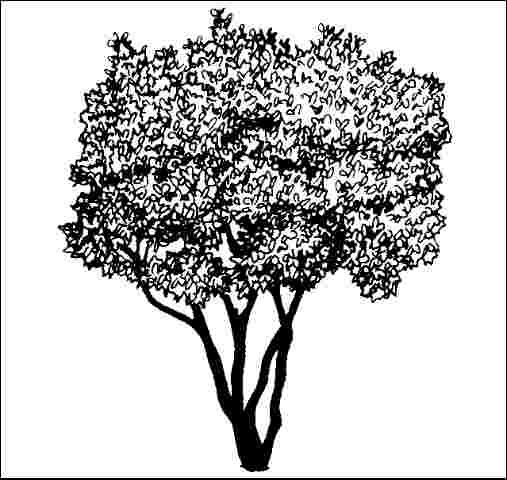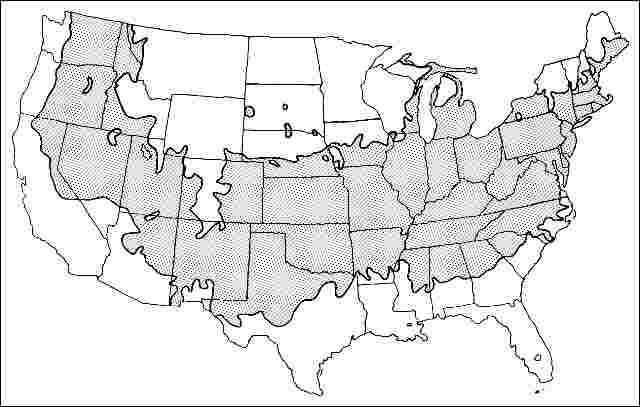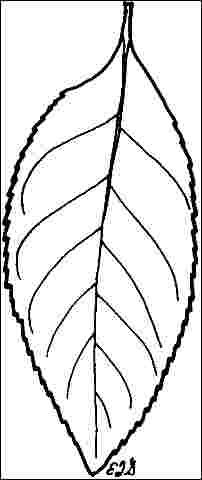Introduction
This deciduous shrub or small tree reaches 15 to 18 feet in height with a spread of 10 feet. The irregular, upright-spreading, oval, dense crown is composed of one to three-inch-long leaves which display great variety of color throughout the year. New leaves unfold as pale glimmers of sunlight brushed with pink, mature to a healthy dark green throughout the summer, then change to yellow, bronze, and vivid red in the autumn. Small, flat clusters of white flowers join the dark green leaves in late May and are followed in October by bright red berries, which persist on the plant into the winter, if not devoured by birds.

General Information
Scientific name: Photinia villosa
Pronunciation: foe-TIN-nee-uh vill-LOE-suh
Common name(s): Oriental Photinia
Family: Rosaceae
USDA hardiness zones: 5A through 7B (Fig. 2)
Origin: not native to North America
Invasive potential: little invasive potentia Uses: sidewalk cutout (tree pit); specimen; street without sidewalk; container or planter; trained as a standard; deck or patio; screen; parking lot island < 100 sq ft; parking lot island 100-200 sq ft; parking lot island > 200 sq ft; tree lawn 3-4 feet wide; tree lawn 4-6 feet wide; tree lawn > 6 ft wide; highway median
Availability: not native to North America

Description
Height: 15 to 18 feet
Spread: 10 to 12 feet
Crown uniformity: symmetrical
Crown shape: vase, oval
Crown density: dense
Growth rate: moderate
Texture: medium
Foliage
Leaf arrangement: alternate (Fig. 3)
Leaf type: simple
Leaf margin: serrate
Leaf shape: obovate, oblong
Leaf venation: pinnate
Leaf type and persistence: deciduous
Leaf blade length: 2 to 4 inches
Leaf color: green
Fall color: yellow, copper, red
Fall characteristic: showy

Flower
Flower color: white/cream/gray
Flower characteristics: showy
Fruit
Fruit shape: round
Fruit length: less than .5 inch
Fruit covering: fleshy
Fruit color: red
Fruit characteristics: attracts birds; showy; fruit/leaves not a litter problem
Trunk and Branches
Trunk/bark/branches: branches don't droop; not showy; typically multi-trunked; thorns
Pruning requirement: needed for strong structure
Breakage: resistant
Current year twig color: brown
Current year twig thickness: medium
Wood specific gravity: unknown
Culture
Light requirement: full sun, partial sun or partial shade
Soil tolerances: sand; loam; clay; acidic; slightly alkaline; well-drained
Drought tolerance: moderate
Aerosol salt tolerance: unknown
Other
Roots: not a problem
Winter interest: yes
Outstanding tree: yes
Ozone sensitivity: unknown
Verticillium wilt susceptibility: susceptible
Pest resistance: resistant to pests/diseases
Use and Management
Its upright form, irregular branching structure, and attractive berries make Oriental Photinia an attractive planting choice for the winter garden, specimen use, or for the mixed shrubbery border. It could also be used as a street tree if it were pruned correctly. It would be recommended for extensive planting if it were not for fireblight disease. Therefore, it is probably best used as a small tree mixed into a shrub border or in limited numbers in urban plantings. It should be tried in areas where fireblight is not a problem.
Oriental Photinia should be grown in full sun or partial shade on well-drained, acid soil.
Propagation is by cuttings or seed.
Pests
No pests are of major concern. Some caterpillars chew foliage and there may be occasional scale infestations.
Diseases
Oriental Photinia is susceptible to leaf spot, powdery mildew, and seriously damaged by fire blight.